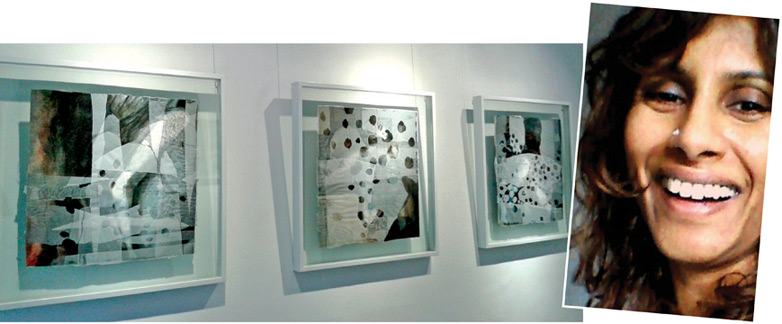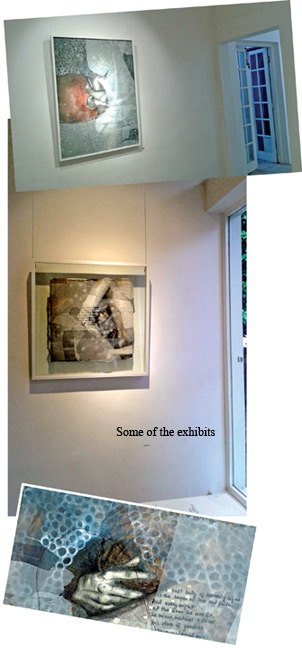|

Layla Gonaduwa |
Quieter Place:
It's all about transition and transformation
By Anuradha Kodagoda
Though I have read a few of her poems and writings before, it was my
first experience of installation art piece of Layla Gonaduwa at Theertha
Red Dot Gallery a few weeks back at 'Me and my space' exhibition held in
collaboration with a few women artists.
To call that her masterpiece is not going to be a hyperbole because I
was really moved by the creativity that she could come up with through a
simple idea of her day-to-day busy life as a mother of two and a
full-time-artist.
Nobody would believe it's just an aluminum pot from her kitchen that
she transform into her masterpiece of art while explaining the conflict
between motherhood and artistic callings in her day today life.
She said, "it takes approximately 15 minutes for this aluminum pot of
water to boil. It is the first thing on the fire at dawn and the last at
night. Between this start and end, chores of the day including boiling
of water are carefully planned and synchronised to save bits and pieces
of minutes.
The minutes add up to a slice of the day that enables me to dedicate
my time to artistic ventures. It is a daily struggle to organise within
a restrictive framework of hours and minutes, for creative endeavours
when it should be constant. It's frustrating and often despairing."
'Quieter Place' is her newest solo exhibition at the Theertha Red Dot
Gallery, Borella and will conclude on November 15.
In an interview with Montage, she expresses her candid views on art.
Excerpts:
Question: What is 'Quieter Place' about?
Answer: A Quieter Place is about transition and transformation.
Acceptance and letting go. Time makes it happen. Repetition of thoughts
give way to new perceptions through contemplation and reflection.
Have I concealed or exposed? Conceded and buried? Resurrected and
reinvented?
The collection is intensely personal, built layer by layer over seven
years, creating a new space.
The process of creating new space is done with screening, erasing,
concealing, layering and even then what is underneath seeps on to the
surface.
There is a transparency that enriches rather than diminishes the
quality of the present. It is an intriguing exercise to sift through the
layers, having to walk back, to go forward to the surface.
The layers have gone through a tumultuous history for its
explicitness, content and circumstance.
Incident
My view of it had been contained in its emotion, composition and the
therapeutic value derived from it at the time.
It has been an exhausting decision to exhibit this collection. Time
and the space had to be conducive to its content, as well as taking into
account the society's response. And that time is now.
Q: What made you to become an artist?
 A: There was no particular incident or concrete plan to
'decide' on being an artist. It was always understood by my parents and
those around me, that I was creative and unconventional. A: There was no particular incident or concrete plan to
'decide' on being an artist. It was always understood by my parents and
those around me, that I was creative and unconventional.
As a child I drew on every surface I could think of. I hated
colouring books and in school I would not follow instructions which did
not make sense to me and quelled the freedom I thought I should be
awarded in a subject such as art.
Of course it became a problem. I did not study art, but continued to
paint and experiment with material at home. This practice has been with
me right throughout to adulthood.
If there was one person who encouraged me it was the late Nalini
Weerasinghe of Cora Abraham fame who was a firm believer in freedom of
expression for children through art. I attended her classes which is a
travesty to be labelled as 'classes'.
It was pure joy to be guided in material use and practice sharpening
my perception and understanding of my surroundings rather than 'learn'
how to draw a tree.
This childhood phase enabled me to develop my own style and own take
on things later in life.
Eight years ago, after stints at Deutsche Bank and then as the Vice
Principal of Cora Abraham, which I had joined after returning to Sri
Lanka, I decided to resign and take my passion seriously and full time.
I have not looked back.
Influences
Q: Where you draw the influences from for your art pieces?
A: Initially it had been from my surroundings and nature. I
started experimenting with firing glass enamel, which basically is
powdered glass, on copper and learnt how to manipulate it in heat.
The technique and the effects I was creating evoked sensitivities I
encountered and experienced with nature.
But gradually I started incorporating personal as well as social and
political issues that drew me in and held my interest.
With this my mediums changed too from fired glass to text to paint. I
have worked with vastly different material and inspirational content.
For example, for the Biennale I worked with an ancient text in
rewriting three different versions of the same six chapters, within a
framework of 2348 letters. I rearranged the same words and letters to
create a work titled The SilverFish.
Silverfish is a pest that attack books and in the context of my work,
symbolically stealing matter and meaning away from the original site. My
intention was to bring to attention the fragility of written history and
the bias of singular perception and how time and translation by
rewriting, rereading and passing on most often, distort and the dangers
of it.
Meaning
Q: What does art mean to you?
A: The term 'art' is as elusive as quicksilver and continues
to evolve. For me it is my language of expression that evoke visually or
emotionally a response.
Q: What does the word 'contemporary' mean to you?
A: Contemporary art simply means art of our times as in the
21st century, in the present context.
Q: Nowadays it has become a trend to showcase 'meaningless'
odd stuff in galleries under the tag-line of 'contemporary art'. Do you
think anything could be an art piece?
A: There are several ways of addressing this question. In a
way art produced today can be termed as 'Contemporary Art'. But then it
does not question nor challenge the quality of the work.
Anything created today can be termed as 'Contemporary Art' if you
take a radical view. But then art in terms of visual and emotional
appeal at some point has to be fulfilled for it to be a piece of art.
Ideally the content, the concept, the message, the use of material, the
process and the visual imagery, all lend to the appeal of the piece.
Then perhaps the word 'Contemporary' has been misused or generalised
for want of a more specific genre or name. One could only debate the
impact or the appeal of a work of art or whether it is art. The word
contemporary is hard to be debatable as long it is current.There lies
the question, is it art, or is it contemporary?
Q: How has your life changed by becoming an artist?
A: That is a complicated question.Perhaps if I take into
account my practice and the time I dedicate to it, it might be easier to
answer.
Then it is an all-consuming passion that strives alongside my
responsibilities as a mother. It is tough.
On another level, I like to think that as an artist I have a social
responsibility and can use art as a tool to fulfil that role.It has
enabled me to think outside the box in every context, be more attuned
with my surroundings and be creative in my solutions, mostly for the
better. |

